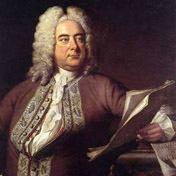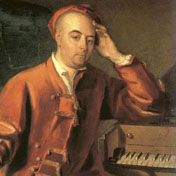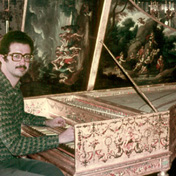Excerpts from this book:
Fig. 3 - Title Page of the edition by Leclerc, Paris 1736.
INTRODUCTION
Handel published his “Suites de Pieces Pour le Clavecin, Premier Volume” on 14 November 1720, in a nicely engraved edition complete with a decorated title page and an ornate “Fine” at the end of every Suite. This edition was followed within a few years by reprints and by other editions. These publications and contemporary manuscripts show many—although relatively minor—differences. Years later Handel published further volumes with more Suites and miscellaneous pieces, but this initial set, commonly known as “Eight Great Suites”, was widely known and admired at the time, and remained forever Handel's favourite keyboard work. ...
When it comes to composers’ first publications of keyboard works, it is revealing to draw a parallel between J.S. Bach, F. Couperin and Handel: ...
THE SOURCES
Other than Handel's own edition of 1720 with later reprints, quite a few contemporary editions and manuscripts are preserved. Occasionally throughout the score they show different readings, and these differences are inevitably reflected in modern editions. Our edition is based on the following seven sources: ...
FINGERING AND HANDEL
... The goal of performing on historical instruments is to try to play an early music score with the overall sound, articulation, ornamentation and other subtleties the composer had in mind. To achieve this, we have to play a “period instrument” with a “period technique” ...
Once the complete Baroque technique is well understood, its practical use becomes significantly easier. Hopefully, the author's Baroque Fingering Method—based on collating the historical sources—and now the present fully-Baroque-fingered edition of Handel's Eight Suites, will help both students and professional harpsichordists to achieve the stylish rendering that these keyboard masterpieces deserve.
The fingering included in the present edition is the author's hypothetical historical reconstruction of a fingering the composer would have approved of, and we have tested these fingerings on different keyboards. ...
HARPSICHORD REGISTRATION
Only towards the middle of the 18th century did harpsichord stop disposition in England “standardise” into the well-known two-manual late-Baroque English instrument, with peculiar features such as the “swell”, the “machine pedal” and the “lute and dogleg” arrangement instead of a manual coupler. However, two-manual harpsichords with lute and dogleg already existed in England in Handel's time, and we have provided in our comments below registration suggestions for such an instrument (disregarding the post-Baroque “machine pedal”). In the very few pieces where our two-manual registration is different according to whether we mean an English or a French instrument, we have provided both alternatives.
In our comments for each of the individual movements in the Eight Suites we have included no registrations for the following dances, for which our common suggestion is as follows:
- Allemandes are best served by the solo lower 8'.
- Courantes and Correntes are best played employing the “mixture” sound of the lower 8' + 4' combination.
- Gigues/Gigas in most cases are best played with the “full harpsichord” 8'+8'+4' combination, yielding an assertive end to the suite.
We have seen that the Eight Suites were not specifically meant for a two-manual harpsichord, yet they provide a few opportunities to use the English-style two manuals to good effect. Anyway, our registrations can be easily adapted to French-style instruments as well as single-manual ones with two stops. The following is a relatively obvious conversion table: ...
COMMENTS ON THE MOVEMENTS ...
Suite I in A major
...
Allemande
STYLE. A typical French Allemande moving in semiquavers. The way internal voices move, as well as the passages in thirds in the r.h., are strongly reminiscent of devices commonly found in Allemandes composed by contemporary French clavecinistes. Unlike a J.S. Bach, Handel makes no pretentions of strict counterpoint: in system 2, bar 2, 3rd beat, the alto-voice f#'-e' is followed by c#' in the tenor and d' in the bass. To make matters more complicated, the large intervals within this passage require continuous changing of hands within the same melodic line.
RHYTHM. The best (but not the only) historical evidence for notes inégales in French Allemandes in metre “C” in semiquavers is St. Lambert (footnote 61). Very interestingly, in some semiquaver pairs that carry a shake (trill or mordent) over the first note, Handel dotted it, making more time available for the shake repercussions. This is the first of many reminders that Handel was making the score legible to amateurs: even without a written-out dotting, Baroque style mandates a dotted execution after a shake, and in a French-style piece this is equivalent to playing “strong” inégales. All these features identify a particularly slow tempo: our suggestion is quaver=90-94.
ARPEGGIO. The final chord of each section should be played arpeggiato.
FINGERING. The first bars of this movement are difficult to play with any type of fingering. The l.h. has more than one passage showing how useful the passing of 5 “below” 4 is, ... . The penultimate bars of each binary section provide nice exercises for the r.h. in the Baroque fingering for scales in thirds.
...
Suite V in E major
...
Air
EARLIER VERSION AND TITLES. An earlier version in G major of this Air with 5 Doubles is included in Smith as an independent piece entitled “Chaconne”. ... The popular nickname “The Harmonious Blacksmith”, supposedly referring to the composer having heard a skilful blacksmith hammering out a musical air, is an urban myth originating in early 19th century.
STYLE. What begins as a four-voice chorale, soon thins down to just two voices, then we have passages with 3, 4 and 5 voices. ... In spite of the French titles, this Air and Doubles are truly in Italian style, as confirmed by the original slurs in the first bars of the Double 1. ...
SCORE. Hicks (possibly by analogy with Double 1) included a tie between the 1st bar's last e crotchet and the 2nd bar's initial e quaver: however, there is no such a tie in the sources, and furthermore the “untied” clash e-f# is charming. Therefore we see no reason for such a tie and have fingered accordingly in the 2nd bar the first two l.h. quavers as 4 and 3. The only original articulation mark in this Air is found in the 2nd system, 1st bar. Here Handel/Cluer has a slur between the demisemiquaver a' and the semiquaver b', an obvious error, fixed in the other first editions (and in our edition as well) so that it slurs the two demisemiquavers g#' and a'. Incidentally, there is no reason to extend the slur to the b', as in most modern editions.
In the second section of the Air, both Steglich and Hicks carry four optional trill signs—either printed small or between parentheses—that presumably originate from manuscripts. These trills are not found in contemporary editions ...
ARTICULATION. Many players succumb to the tradition of playing this Air legato throughout. Students should always bear in mind that during the Baroque era and beyond this was never the recommended default articulation and, when present, was considered in bad taste. This said, quite a few legatos are indeed stylish, for example slurring the upper voice's quaver pairs and semiquaver pairs, but other notes are to be non-legato or detached.
REGISTRATION. The lower 8' is ideally suited for this Air.
Double 1
STYLE. The over-legato lute-style texture in the first four crotchets remarkably thins down to a single l.h. voice in the 2nd bar. ...
ARTICULATION. The original “Italian” slurs show how to articulate Double 2 as well.
TEMPO. In this as in the other Doubles modern taste shows wide variations: some like it very fast, others very slow. Most players prefer to play this Double faster than the Air, and each next Double faster, but an interesting contrary evidence ... . I prefer to play Air and Doubles at the same speed.
FINGERING. In system 2, first bar, 3rd beat, 3rd semiquaver b', a pianist would finger 4 or 5, so that the hand gradually moves down as needed by the last four semiquavers in the bar. However, this is an excellent passage to exemplify a feature of traditional harpsichord technique: we keep the hand steady to guarantee uniformity, and then we shift the hand to the left for the last four semiquavers.
REGISTRATION. For variety, let us use the upper 8'.
...
EXCERPTS FROM THE SCORE
Suite I, Prélude:
Suite V, Air:


